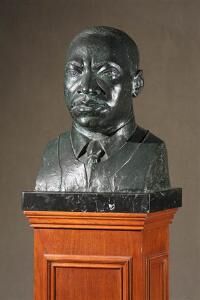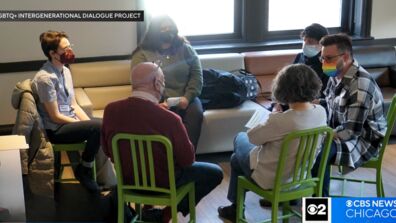
Honoring Dr. Martin Luther King Jr.
Artist, activist, and School of the Art Institute of Chicago (SAIC) alum Elizabeth Catlett (SAIC 1941) made a striking portrait bust of Dr. Martin Luther King Jr. in the late 20th century. As the United States recognizes Dr. King’s extraordinary leadership, deep humanity, and commitment to confronting injustice with today’s national holiday, Catlett’s sculpture reminds us of the vigilance and persistence in opposition to racism and oppression that we are called to by his example.

Catlett’s life-size representation of Dr. King is made of bronze, with a realistically sculpted head and neck that transitions into a more abstracted upper torso that does not quite reach the shoulders in width. Catlett’s Dr. King wears a necktie, as he customarily did in public life, but the other minimally implied garments suggest academic regalia or the clerical vestments of Dr. King’s ministry, uniforms of vision, purpose, and knowing. The silhouette is strikingly symmetrical, balanced, and sturdy; however, the visage is not one of repose, but revelation.
Dr. King, though closed-mouthed with eyes focused on a distant horizon in Catlett’s depiction, has furrows between his eyes—as if struck by a new truth—and along his cheeks—as if on the threshold of oration. With features slightly larger than life, the sculptural Dr. King sees farther into our world and further into our future than we can. His hearing is more candid, and his speech more global. It is as if this image of Dr. King is privy to the real Dr. King’s view from the mountaintop.
Through the prism of Catlett’s art, I clearly perceive the mandate Dr. King leaves to us, the artists, designers, and scholars of SAIC. We must be vigilant, awake to systemic racism and habituated dehumanization. We must also be persistent, acknowledging our missteps and setbacks while nevertheless striving to create a campus inclusive of all people, regardless of race, national background, gender identity, sexual orientation, disability, or any other difference. Together, let us rededicate ourselves to overcoming all forms of oppression and lead by example for the city we study in, the countries we come from, the peoples we are, and the culture—inclusive and dynamic, contentious yet collegial—that ought to be.
Achieving these dreams will require us to heed the lessons of Dr. King and to hear wisdom from our own students, faculty, staff, supporters, partners, and alumni, like the late Elizabeth Catlett, whose perceptiveness continues to nourish us. Only together can we make an increasingly inclusive place for everyone: a school in which our differences create strength, our artmaking and scholarship embrace diversity, and our achievements help affect positive change throughout SAIC and beyond.
Elissa Tenny
President
